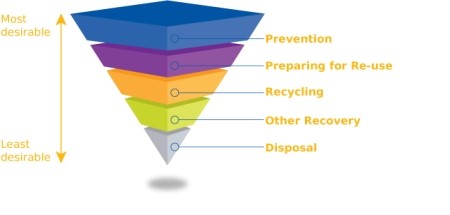Materials and Waste Management
- Advice on the definition of waste
- Support for the implementation of the CL:AIRE Definition of Waste Code of Practice
- Provision of Qualified Persons to review CL:AIRE Code of Practice documentation
- Preparation of documentation to support the fulfilment of End of Waste criteria
- Submissions to the Environment Agency Definition of Waste Panel
- Preparation of Waste Recovery Plans
- Waste characterisation
- Advice on applying the waste hierarchy
- Hazardous waste classification
- Planning and permit applications
- Technical and expert witness reports
Directive 2008/98/EC on waste which is known as the ‘Waste Framework Directive’ or ‘WFD’ sets out the basic concepts and definitions related to waste management, such as definitions of waste, recycling and recovery. It explains when waste ceases to be waste and becomes a secondary raw material, the so called End of Waste criteria, and how to distinguish between waste and by-products. The WFD introduced a revised waste hierarchy including new concepts such as ‘preparing for re-use’ and ‘other recovery’. MJCA works with businesses across all levels in the waste hierarchy.

MJCA provides advice to companies which help prevent materials being classified as waste under Article 3(1) of the WFD and thereby become subject to the increased cost and regulatory burden that is associated with the management of the materials as a waste. A good example is material that arises from demolition, earthworks or site remediation activities which may not comprise a waste depending on the nature of the materials, how they are going to be used and site specific circumstances. We provide advice to developers and contractors on the most appropriate way for managing such materials as non-wastes including the use of the “Definition of Waste: Development Industry Code of Practice” published by Contaminated Land: Applications in Real Environments (CL:AIRE). The re-use of materials in development projects can support the sustainable remediation and redevelopment of contaminated sites bringing them back into productive use (see our Contaminated Land services).
The CL:AIRE Code of Practice (CoP) provides a framework for determining whether or not excavated material used in land development is waste. It prescribes the circumstances under which re-use can be considered and under which waste can be considered to have been recovered. We have the experience necessary to prepare the documentation that provides the auditable system necessary to demonstrate that the CoP has been adhered to on a site by site basis and that materials have been used correctly as non-wastes. MJCA has a number of Qualified Persons (QPs) who can review the documentation prepared under the CoP and complete the necessary declaration under the CoP.
Article 6 of the WFD sets out the basis on which criteria can be developed that must be achieved in order to demonstrate that a waste which has been recovered fully is no longer a waste and therefore not subject to waste regulatory control. We have the experience necessary to prepare the documentation that is required by businesses to demonstrate that relevant End of Waste criteria have been met for their products. Routinely this will comprise the preparation of a suitable written Quality Management System (QMS) that includes an appropriate documented Factory Production Control (FPC) and Method Statement of Production (MSP). These documents provide the framework within which the business will generate the evidence that can be used to demonstrate to customers and the regulator if necessary that the materials have achieved End of Waste status and can be sold and distributed legitimately as products that meet all relevant standards and specifications.
Commonly the relevant End of Waste criteria will be defined within a published Quality Protocol or European Commission (EC) Regulation. Where there are no published End of Waste criteria for the particular product that is being manufactured it is possible to obtain a product-specific End of Waste decision. We have the necessary technical experience to prepare an End of Waste submission. We provide advice to businesses on the information that will need to be collected to support a submission which is likely to include suitable robust laboratory testing. Obtaining an End of Waste decision reduces the potential risks to the business of unnecessary investigation or enforcement action by the regulator into the legitimacy of the products and potentially provides a competitive commercial advantage.
Where a material does meet the definition of a waste under Article 3(1) of the WFD it is essential that the waste is classified correctly so that it can be managed appropriately to minimise potential impacts on human health or the environment. We have extensive experience in the characterisation of waste including inert waste and hazardous waste. The classification of waste as hazardous or not is complex and often misunderstood. We have developed and use a proprietary model to characterise hazardous waste in accordance with Environment Agency guidance. The model is updated with changes to the legislation and guidance so that it continues to take account of the latest requirements when characterising waste material as hazardous.
MJCA’s materials and waste management services are supported by our experience in gaining the authorisations to progress a development and to operate an industrial process or to undertake a waste management activity where this is appropriate (see our Planning and Environmental Permitting Services).
For more information on services provided by MJCA please contact us using the details provided below

